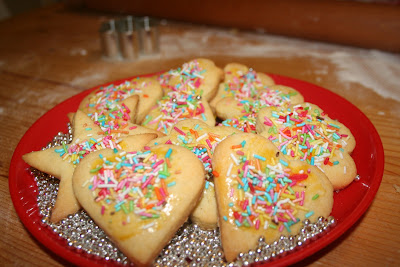INGREDIENTS
1 kg flour
6 eggs
400 g butter
500 g sugar
1 packet baking powder
colored sprinkles
chocolate sprinkles
smarties
PREPARATION
Draw the outline of the Befana on the card or a horse, cut it and cover with aluminum foil, at least you can use several times. Pour the flour on a pastry flour Add eggs and mix Add butter sugar and the packet of baking powder. In the mean time preheat the oven at 180. Mix quickly until the dough is quite elastic and compact. Form the dough into a ball, wrap it in a tea towel and place it in the refrigerator for at least half an hour. After half an hour, remove the dough from the refrigerator and roll out it on a lightly floured pastry flour. Use a rolling pin. Achieve a thickness of about half a centimetre.
Place the shape obtained on the pastry and cut the edges with a knife. Arrange the shape obtained on a baking sheet with parchment paper. Brush the fantoccia with beaten egg yolk. Decorate as the most preferred, smarties, colored sprinkles, chocolate sprinkles ..... given free rein to your imagination. Place in preheated oven +180 degrees for 15 minutes. Once removed from the oven, you can continue decorating with grains of sugar. If you want you can melt in a water bath a little 'chocolate, after you put it in a pastry bag and you can decorate your fantoccia.
With the pastry advanced, you can make good biscuits, the procedure is the same, use of stencils and colored tails to decorate.
1kg farina
6 uova
400 gr burro
500 gr zucchero
1bustina di lievito per dolci
smarties
confettin colorati, al cioccolato
zuccherini
PREPARAZIONE
Disegnate sul cartoncino la sagoma della Befana o di un cavallo, ritagliatela e ricopritela con la carta d'alluminio, almeno la potete utilizzare varie volte.
Mettere la farina aggiungendo uova e mischiare Aggiungere burro e zucchero, poi aggiungere bustina di lievito. Nello stesso momento pre-riscaldare il forno a 180 gradi. Mischiare velocemente finchè la mistura non è elastica e compatta. Fare una palla della mistura e mettere in uno straccio lasciando riposare la palla nel frigorifero per almeno 30 minuti. Dopo circa 30 minuti , rimuovere la palla dal frigorifero e stenderla fino ad uno spessore di circa 0,5 cm Posizionate la sagoma ottenuta sulla pasta frolla e tagliate i contorni con un coltello.
Disponete la sagoma ottenuta su una teglia con la carta da forno. Spennellate la fantoccia con un tuorlo sbattuto. Decorate come più preferiti, smarrireste, codette colorate, al cioccolato.....date sfogo alla vostra fantasia. Mettete in forno già caldo a180 gradi per 15 minuti. Una volta tolta dal forno, potete continuare la decorazione con chicchi di zucchero. Se volete potete far sciogliere a bagno maria un po' di cioccolata, dopo di che la mettete in una sac à poche e potete decorare la vostra fantoccia.
Con la pasta frolla avanzata, potete fare degli ottimi biscotti, il procedimento è lo stesso, usate degli stampini e delle codette colorate per decorare.



